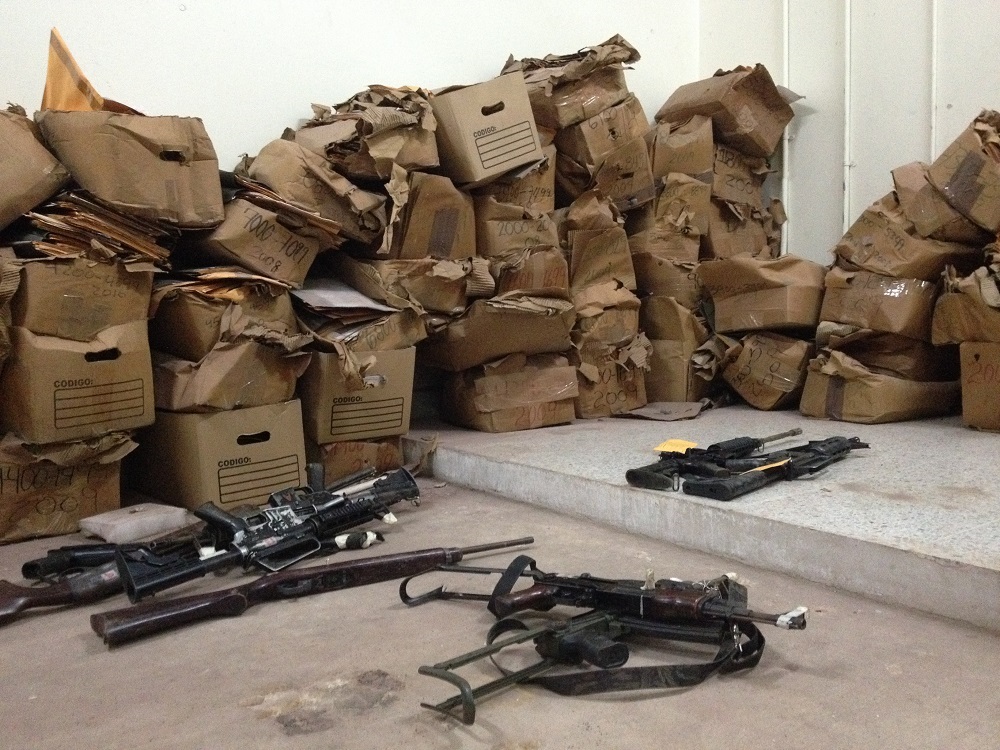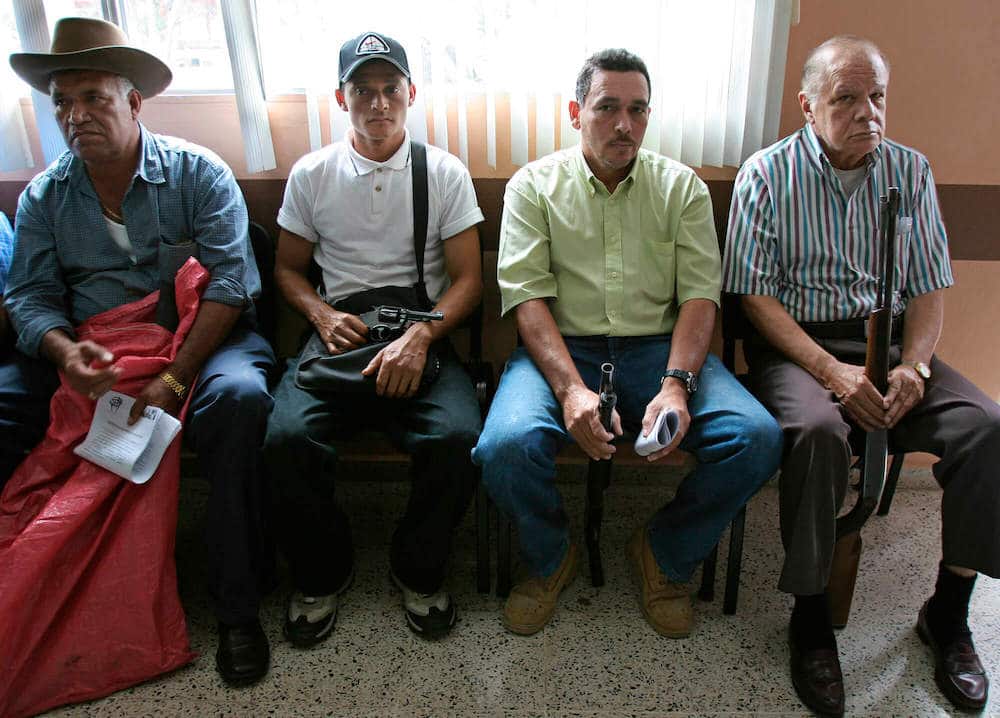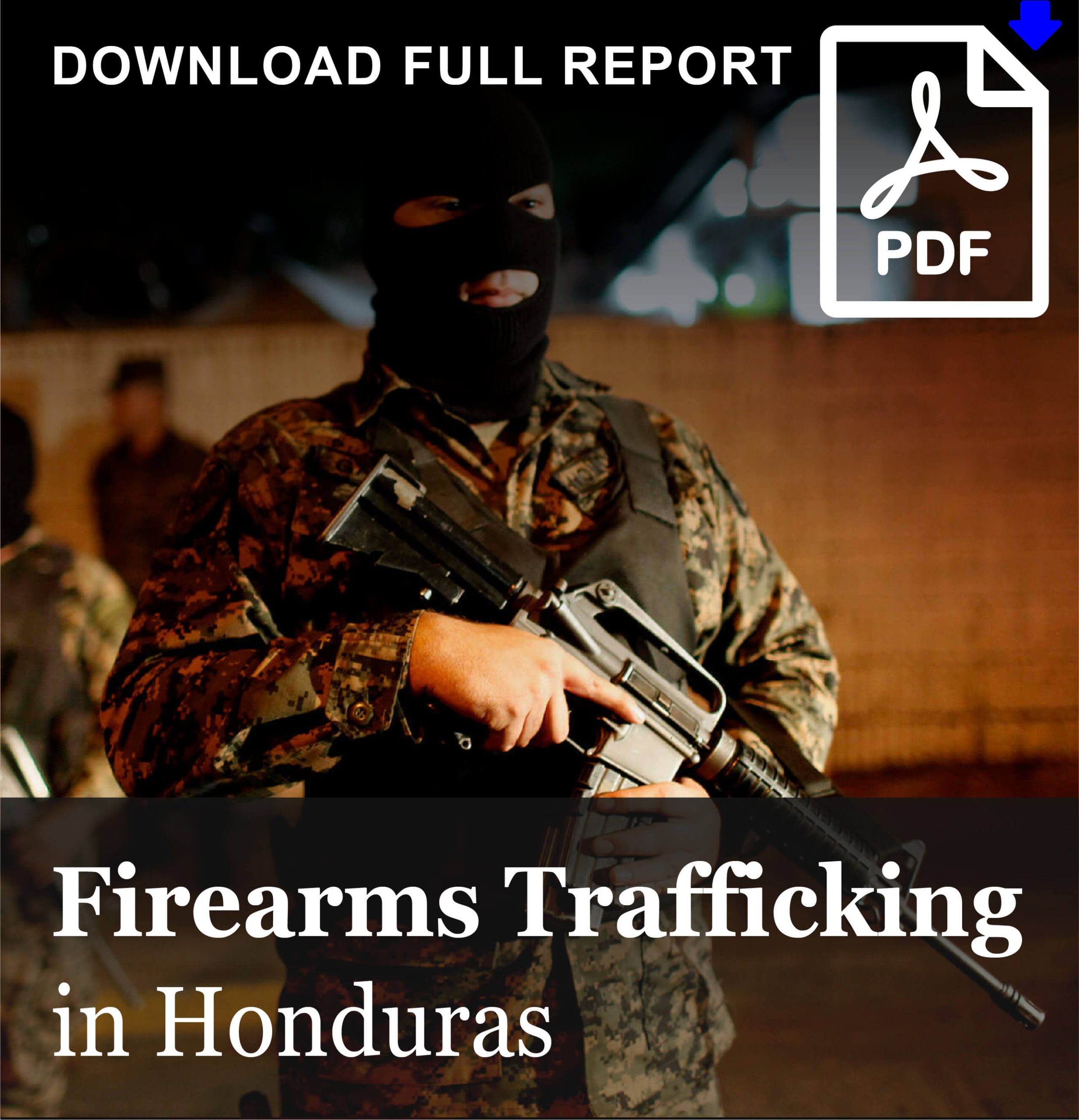As set out in this report, the legal structure around Honduras’ arms trade is deeply flawed. The legislation is inconsistent and unclear as to the roles of different institutions, while the regulatory system is insufficiently funded, anachronistic and administered by officials who are overworked or susceptible to corruption.
As noted, there is a massive backlog in carrying out ballistic tests on registered firearms. Given the current rate that these tests are carried out, it would take 30 years to register the ballistic traces of all the country’s legal weapons.[1]
The lack of a centralized database is a serious problem for arms control. The databases that exist are not regularly cross-checked against one another — for example, the Armory does not check potential weapon purchasers against the database of gang members.
There is no consistent policy for destroying seized firearms. Under the law, the security secretary has the power to order weapons destroyed in the case of “damage or extreme danger.”[2] There are also shortcomings in how police handle seized firearms, with a lack of clear chain of custody. Seized firearms are stored by different entities across the country, with little centralized control. A recent audit to count the weapons held by the Attorney General’s Office, for example, found that they were storing some 4,000 weapons across the country.[3]
Another serious issue is the lack of trained personnel. There is no specialized unit within the police that handles arms trafficking cases.[4] The armed forces, including the military police force, the Military Police of Public Order (Policia Militar de Orden Publico – PMOP), are charged with combating arms trafficking in cooperation with the police, but there is no unit dedicated to this.[5]
The poor training of officials involved in gun control is manifested in their lack of understanding of the tools; for example, IBIS is used as a way to register guns, not as a way to prosecute violators, track criminals or do sophisticated criminal analyses, which it is designed for.
An additional issue is that combatting arms trafficking does not appear to be a high priority for the government. It is working with its limited resources to solve the cases that have reached the courts, but a substantial number never get to that stage. As is widely reported, the vast number of homicides and other crimes are never resolved by the justice system.
The ballistics unit of the Attorney General’s Office is a case in point. The unit is chronically understaffed and woefully underpaid (entry-level staff receive minimum wage). They are not compensated for overtime. Their working conditions are precarious (the San Pedro Sula office burned down, taking with it years’ worth of data). The storage areas are vulnerable to accidents (thousands of files were damaged in a recent rainstorm) and open to theft (the entrance to the area where they stored their weapons in Tegucigalpa in the parking area of the forensics medicine building had no working lights when InSight Crime and ASJ visited in February 2015).

Improvements in Recent Years
However, Honduran authorities have begun implementing a number of promising anti-arms trafficking measures in recent years, with varying degrees of success.
First, they have tightened security at legal points of entry to the country. Authorities told our researchers that trafficking has been curbed in recent months, due to increased vigilance and the implementation of improved security at key points of entry. This includes Puerto Cortés on the northern coast, which is Honduras’ busiest port. Puerto Cortés has undergone a renovation worth hundreds of millions of dollars, including the addition of extra x-ray machines to scan containers.[6] There have also been efforts to train staff at other points of entry to better detect weapons, including a recent course to help police and customs officials identify weapons and parts being smuggled, with training provided by Nicaraguan and Colombian police.[7]
Second, authorities have increased patrols around informal points of entry to the country in a bid to cut arms trafficking. In March 2015, the Honduran government launched a bilateral force along with Guatemala, the Inter-Agency Task Force Maya Chorti, to fight organized crime on the border, combining police, military personnel and prosecutors.[8] The Honduran anti-crime task force known as FUSINA has also been working on the borders with Guatemala, Nicaragua and El Salvador[9] to destroy unmonitored crossing points, or “blind spots,” using explosives and bulldozers, in order to prevent these crossings being used for the illegal transport of weapons and other goods.[10] In one of its first weeks of operation, the Maya Chorti task force reported that it had seized six AK-47s; rifles ranging from M16 to FAL; a 12-gauge shotgun; seven pistols; and various types of ammunition.[11]
Moreover, Honduras’ Security Minister Julián Pacheco has publicly recognized the problem of arms trafficking in border states. He heralded the results of an operation in Olancho, the state with the highest number of registered weapons in the country,[12] stating that arms trafficking in the region had been tolerated for many years, but that the security forces were putting a stop to it.
“You can see what kind of people we are talking about from the quantity of weapons that are being seized each week,” he told the press.[13]
Third, there have been various efforts to tighten Honduran gun laws. At the time of writing, the Honduran Congress was considering preliminary versions of proposed reforms. Some versions would reduce the number of firearms that can be registered to each person to three, down from five, and increase the penalty for possession of an illegal weapon to a maximum 12 years in prison. There are also proposals to solve the backlog in ballistic testing by creating several offices in cities across the country where tests can be performed,[14] and to restrict purchases of ammunition to those with a license for the corresponding gun. One version of the reforms would prevent gun owners from pawning their weapons.[15]
Honduran authorities have also indicated that they will act against the domestic illegal trade in arms and ammunition. In May 2015, La Prensa published an investigation showing that Tegucigalpa shops were illegally selling bullets.[16] The following day, the government announced an investigation and operations to shut down this trade. Congressman David Chávez, head of the Congress Defense Committee, said that the new law on the arms trade would include “tough regulations, controls and sanctions against small businesses in the informal economy which trade in projectiles.”[17]
Conclusions
Honduras is suffering from one of the highest homicide rates in the world, part of which is fueled by the wide availability of firearms. Over 80 percent of all homicides occur at the hands of someone wielding a gun. The availability of weapons is in turn fueled by liberal gun laws, lax and corrupt regulators and the illegal trade that takes place — almost unchecked — across Honduras’ borders and on its streets.
Still, arms trafficking in Honduras is difficult to monitor. It does not follow any single route and is not dominated by any single group. Honduras does not produce weapons, and its sole importer and salesman — the Honduran Armed Forces — does not release any information on what it imports or sells to the public. The regulatory agencies are many and the government has yet to create a central database for legally registered weapons.
In addition, the varied and opportunistic nature of the trade makes this a very difficult crime to understand and to counter. There are so many parts of the system that are broken that Honduras’ black market arms trade has become a fairly democratic criminal enterprise. From a housewife to a former military officer, there is so much opportunity for purchase and resale of weapons and munitions, and so little chance of getting captured and punished, that it is quite literally the crime that pays.
The United States is doing its part to fuel this trade. Weapons purchased in the United States represent close to half of all weapons found at crime scenes in Honduras — or higher, in the view of Honduran officials. The United States is the source of many weapons that are trafficked directly to the country, as well as those that come indirectly via Mexico and Panama. Indeed, the United States was responsible for many of the weapons that entered Central America during the civil wars of the 1980s and 1990s, and which continue to stream into Honduras today. These same weapons now leak from military stockpiles into the black market that flourishes throughout the region.
But while lax regulations, liberal gun laws and old weapons stocks in other countries facilitate this trade from abroad, contradictory legal statutes, corruption, malfeasance and bureaucracy fuel the local black market in Honduras. The problems start at the top. The Honduras military refuses to be held publicly accountable for the illegal movement of weapons, even though it may be a source of illegal arms. The police — the institution with nominal control over the national registry — has limited resources and refuses to take responsibility for the chaotic nature of the gun registration system in Honduras, as well the poor control it administers over the private security firms. The Attorney General’s Office has yet to use the tools provided to it to slow criminal use of black market weapons.
Moreover, the government has shown little will to change the behavior of any of these institutions, provide them with the resources they need, or institute consistent legislation that outlines clear restrictions on gun ownership or enforces meaningful penalties. On the contrary, while some elements of the security forces have joined in the fight to stop the flow of illegal weapons into Honduras, the internal mechanisms needed to keep high-powered rifles out of the hands of organized crime groups are not implemented or are poorly understood. This also allows private security companies to obtain, own and use these weapons without repercussions.
Honduras was taking the first steps toward tightening its rules on weapons ownership (though similar legislative initiatives have failed in the past). This is welcome, but it should be accompanied by legislation that clearly sets out the roles and responsibilities of different government agencies in regulating the arms trade, and mandates the sharing of information between them via a centralized database of arms seizures, purchases and other information. The reform should also fill in basic holes in the existing legislation, such as by supplying definitions of key terms like “firearm.” Moreover, as well as tightening controls on firearms, it is vital that Honduras increases controls on ammunition.
Transparency is key to tackling the illicit arms trade in Honduras. In order to design and implement effective measures it is necessary to gather accurate data on the size of this industry and the methods used to move weapons. The security forces should be obliged to share data on their purchases and measures they take to prevent losses from their stockpiles, while private security companies should be more closely regulated and obliged to report on their arms holdings. In the absence of detailed information from these two important groups, researchers and policymakers will be left in the dark about the real scale of arms trafficking in the country.
* The InSight Crime team for this report was led by InSight Crime Co-director Steven Dudley and then InSight Crime Assistant Director Elyssa Pachico. Research was led by Steven Dudley and Mario Cerna, a long-time journalist from Honduras. The report was written by Steven Dudley. Special contributions were made by Mario Cerna. Translation into Spanish by Diego García and María Luisa Valencia. Editing and fact-checking by Mike LaSusa, Felipe Puerta and Victoria Dittmar. Graphics by Elisa Roldán. Top photo by Associated Press/Ginnette Riquelme. Report photos by Steven Dudley. InSight Crime would like to give special thanks to ASJ for its support and assistance.
[1] El Heraldo, “Honduras: 235 mil armas sin prueba de balística,” 7 April 2015. Available at:
[2] Ley De Control De Armas De Fuego, Municiones Explosiones Y Otros Similares (Art 53)
[3] El Heraldo, “Unas 4,000 armas decomisadas serían distribuidas,” 20 February 2013.
Available at: https://www.elheraldo.hn/csp/mediapool/sites/ElHeraldo/Sucesos/story.csp?cid=621699&sid=293&fid=219
[4] Breakdown of police units in the newly-launched DPI available here: https://www.seguridad.gob.hn/images/organigramas/dpi.jpg
[5] El Heraldo, “Honduras: Resolución de JOH sobre la PMOP,” 25 January 2015. Available at: https://www.elheraldo.hn/pais/788554-214/honduras-resoluci%C3%B3n-de-joh-sobre-la-pmop
[6] Bessy Lara Barrera, “‘La productividad de los buques se ha duplicado,’” La Prensa, 14 June 2015. Available at: https://www.laprensa.hn/economia/849370-410/la-productividad-de-los-buques-se-ha-duplicado
[7] Direccion Ejecutiva de Ingresos, “Funcionarios de Aduanas y Policía Nacional de Honduras recibiran curso para la identificación de armas y partes en contenedores y equipaje,” 2 June 2015. Available at: https://www.dei.gob.hn/website/?art=2117&title=Funcionarios%20de%20Aduanas%20y%20Polic%C3%ADa%20Nacional%20de%20Honduras%20recibir%C3%A1n%20curso%20para%20la%20identificaci%C3%B3n%20de%20armas%20y%20partes%20en%20contenedores%20y%20equipaje&lang=es
[8] Secretaria de Defensa Nacional, “Fuerza Maya Chorti supervisa movimientos fronterizos en zona occidental,” April 2015. Available at: https://sedena.gob.hn/index.php/component/content/article/1-latest-news/475-fuerza-maya-chorti-supervisa-movimientos-fronterizos-en-zona-occidental.html
[9] Proceso Digital, “Honduras: Destruyen nueve puntos ciegos fronterizos con El Salvador y Guatemala,” 18 November 2014. https://www.proceso.hn/component/k2/item/91550-honduras-destruyen-nueve-puntos-ciegos-fronterizos-con-el-salvador-y-guatemala.html
[10] La Prensa, “Honduras destruye “puntos ciegos” en frontera con Guatemala,” 18 January 2015. https://www.laprensa.hn/honduras/786539-410/honduras-destruye-puntos-ciegos-en-frontera-con-guatemala
[11] El Tiempo, “Fuerza Maya-Chorti reporta decomiso de armas, indumentaria militar, lanchas, vehiculos y narcopistas,” 20 April 2015. Available at: https://www.tiempo.hn/nacion/item/27845-fuerza-maya-chorti-reporta-decomiso-de-armas,-indumentaria-militar,-lanchas,-vehiculos-y-narcopistas
[12] La Prensa, “Entre 400 y 500 mil armas circulan en Honduras legalmente,” 19 May 2015. Available at: https://www.laprensa.hn/honduras/841451-410/entre-400-y-500-mil-armas-circulan-en-honduras-legalmente
[13] Proceso Digital, “Olancho: tráfico de armas en la mira,” 9 June 2015. Available at: https://www.proceso.hn/component/k2/item/103896-olancho-tr%C3%A1fico-de-armas-en-la-mira.html
[14] El Heraldo, “Honduras: 235 mil armas sin prueba de balística,” 7 April 2015. Available at: https://www.elheraldo.hn/pais/828600-331/honduras-235-mil-armas-sin-prueba-de-bal%C3%ADstica
[15] El Heraldo, “Fuertes medidas para uso y portación de armas en Honduras,” 16 May 2015. Available at: https://www.elheraldo.hn/csp/mediapool/sites/ElHeraldo/AlFrente/story.csp?cid=566149&sid=300&fid=209
[16]La Prensa, “Venta ilegal de munición crece en mercados de Tegucigalpa,” 18 May 2015. Available at: https://www.laprensa.hn/honduras/841087-410/venta-ilegal-de-munici%C3%B3n-crece-en-mercados-de-tegucigalpa
[17]La Prensa, “Seguridad anuncia investigación y operativos en mercados de Tegucigalpa,” 19 May 2015. Available at: https://www.laprensa.hn/honduras/841450-410/seguridad-anuncia-investigaci%C3%B3n-y-operativos-en-mercados-de-tegucigalpa


